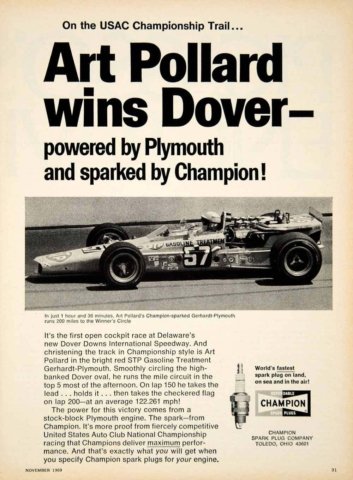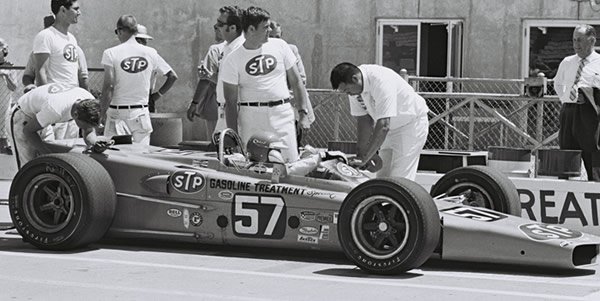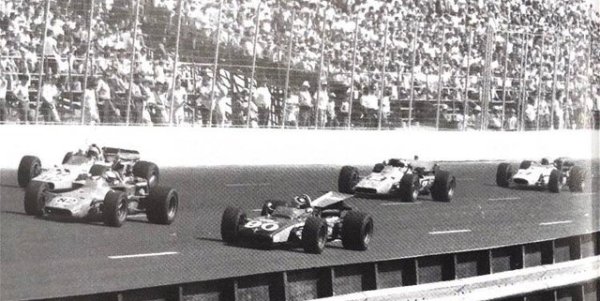
This story really starts when Richard Petty decided he was leaving Chrysler and going to Ford for the 1969 NASCAR season despite having won 16 races in a Plymouth in 1968 and finishing third in the NASCAR point championship.
This left extra money in the Plymouth budget for 1969 and it was decided to use this money to develop a Plymouth high-revving V8 for use in the Indy Car series. Plymouth decided to team up with Andy Granatelli’s STP race team and had engines to Granatelli 90 days after design work had begun.
Special help on the engines were provided by International known British engineer Harry Weslake who had developed the powerful Weslake V-12 engine that Dan Gurney drove in winning the 1967 Belgium Grand Prix. Weslake provided special Weslake cylinder heads for the Plymouth motor.

In 1969, Granatelli racing had three separate teams. The most remembered was the one headed by Clint Brawner with driving Mario Andretti driving which won the 1969 Indianapolis 500. Andretti scored nine wins in 1969 and won the National Championship in a landslide.
Another car was maintained by Andy’s brothers Vince and Joe and a third team was headed by Grant King, a well-known open wheel engineer. It is the Grant King ran team that will ultimately lead to Mopar’s only win in Indy Car racing.
For a chassis, the King operation used a Gerhardt chassis designed by Fred Gerhardt that looked almost identical to the STP Lotus turbines of 1968 except Gerhardt designed them to carry a regular combustion engine since USAC had outlawed the turbines.

While this car ultimately had Plymouth power, it was fitted with an Offenhauser for its debut at Hanford (California) on April 13. Art Pollard qualified the car ninth, but came into pit on lap 67 and a fire occurred in which Grant King received serious burns and crew member James “Red” Stainton was struck and killed by a car driven by Mario Andretti while trying to flee the fire.
The car was then prepared for the Indianapolis 500. Entries were filed for Pollard to drive the #20 car with a Lotus Chassis and Plymouth engine and a Gerhardt Chassis and a Plymouth engine, but neither were ever used. Pollard ended up racing the #40 a Lotus Offenhauser and Carl Williams drove the #57 (the King car) with a Gerhardt Offenhauser but lasted only 50 laps excited the race because of clutch problems.
At Milwaukee the next weekend, Art Pollard qualified the #40 (Gerhardt Offenhauser) fifth but was caught up in a first lap crash. He relieved Greg Weld in the #57 Gerhardt Offenhauser and went on to win the race. At Langhorne, the following week Pollard qualified sixth and came home in second with rain postponing the bulk of the race to the following week. The King car was still a Gerhardt Offenhauser at that point.
Finally, on July 6th, the #20 Lotus was fitted with a Plymouth engine for the race at the Continental Divide Raceways. Pollard qualified the car sixth but quickly retired from the race with brake issues.
On July 27, the Indy Cars ran twin 40 lap events on the 2.5-mile road course at Indianapolis Raceway Park. Pollard driving the #57 with Plymouth did not have a great deal of luck. He started 25thin the first one and retired 16th as the car developed a bottoming out problem. He started 16th in the second event and retired after ten laps in 25th place with universal joint issues.
On August 17th they put the Offenhauser back in the #57 and Pollard qualified tenth and finished with a good solid sixth place finish. So, as the Delaware 200 at Dover approached, the decision was made to put the Plymouth back in the #57 and as they say, the rest is history. Pollard qualified tenth fastest turning the Dover mile in 24.054 seconds for a speed of just under 150 miles per hour.
Second fast qualifier Roger McCluskey got the jump on polesitter Bobby Unser at the drop of the green and led the event early on with Unser retiring after just three laps. McCluskey set a blistering pace and led until lap 34 when he went pitside with a blistered right rear tire. Pollard’s teammate Mario Andretti took the lead and led until giving up the lead to Al Unser on lap 53. Pollard would be in second place.
On lap 115, the yellow waved for the first time in the race and the green did not wave again until lap 128 when race leader Al Unser crashed in the fourth turn giving lead over to Pollard. The race resumed on lap 144, but the caution waved three laps later when Mario Andretti crashed. Finally, on lap 155 the green flag waved and stayed out for the remainder of the race with Pollard winning the event over Gordon Johncock.
 In winning the race for STP and Plymouth, Pollard made just one pit stop on lap 98 for fuel and a tire. It took Pollard one hour 36 minutes and one second to complete the 200 miles for an average speed of 122.261 miles per hour. The win was Pollard’s second of the season and was the only win for a Chrysler (Plymouth) engine in the Indy Car series.
In winning the race for STP and Plymouth, Pollard made just one pit stop on lap 98 for fuel and a tire. It took Pollard one hour 36 minutes and one second to complete the 200 miles for an average speed of 122.261 miles per hour. The win was Pollard’s second of the season and was the only win for a Chrysler (Plymouth) engine in the Indy Car series.
“We are real happy with the engine,” said Pollard in victory lane. “We knew we couldn’t qualify quick because we were short on power, but its smooth power made it easier to handle on the track. When the track got oily, you can handle the car easier with the throttle.” Granatelli echoed Pollard’s feeling and added “This is my biggest thrill beside winning Indianapolis.”
On September 6, they dropped a Plymouth motor in the #80 Silver Crown car for the Hoosier Hundred at the Indiana State Fairgrounds with Pollard qualifying the car third fastest but dropping out of the event very early with handling issues.
On September 14, they raced on the road course at Brainerd, Minnesota with Pollard qualifying the Plymouth powered #57 14th but never really starting the event because of engine issues. The next weekend at the 1.5-mile Trenton International Speedway they put the Offy back in and Pollard qualified 11th and finished 14th.

On September 28, it was back on dirt at the one-mile oval in Sacramento, California with Pollard qualifying the Grant King car with Plymouth power in fifth fastest but finishing a disappointing 14th. On October 19, at the Pacific Raceway in Kent, Washington for a doubleheader, Pollard qualified the Gerhardt Plymouth powered machine 16th but was taken out earlier in and accident in the first race. In the second race he started last in the field and finished 12th after being involved in another accident.
The Indy car season came to a close on December 7, 1969 at the Riverside International Raceway in California with Pollard qualifying the Plymouth powered car 15th and finishing 16th in a huge field of 40 cars.
It had been an interesting experiment and I am sure many looked forward to continuing the experiment in 1970, but the story ends right back where it started with Richard Petty. In 1970, Petty returned to Chrysler (Plymouth) and the funds for the Plymouth Indy car were taken away and Andy Granatelli lost all interest in the project.
Sadly, in May 1973 while getting ready to qualify for the Indianapolis 500, Art Pollard’s car clipped the Turn 1 wall, making a number of violent flips and ending 1,450 feet from the start of the accident. An hour later, Art Pollard was pronounced dead. Racing had lost another great racer.












The Plymouth motor is not a DOHC design. It’s called that in many different articles however it is a simple overhead valve push rod design with Westlake heads on a LA series (273-318-340) engine. If you look at the engine picture you can see the unique valve covers, but no castings for chains that would operate an overhead cam.
You’re 100% correct, Stan. And the article has been fixed accordingly. Thank you.
“Weslake”, not “Westlake”. Gurney and the Eagle won the 1967 Belgian GP, not 1968. Error-ridden article. Pathetic.
The typos have been fixed.
My father did the workup on that engine at Keith Blacks….. It was a rush rush job…. Our family was very proud of him…..